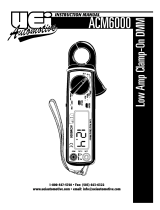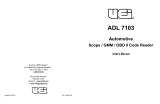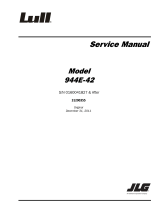C.E. Niehoff & Co N1706 TG Troubleshooting guide
- Type
- Troubleshooting guide

R
Page 1
TG101A
N1706 Alternator
Troubleshooting Guide
C.E. Niehoff & Co.
CONTENTS
Section A: Description and Operation ..............................2
Section B: Basic Troubleshooting ....................................5
Section C: Advanced Troubleshooting ............................6
Battery Charging Conditions
The following conditions may be observed during cold-
start voltage tests until temperatures of electrical system
components stabilize. The time it takes to reach optimum
voltage and amps will vary with engine speed, load, and
ambient temperature.
Maintenance/Low Maintenance Lead-Acid Battery:
Traditional lead acid batteries require lowest charge volt-
age of all vehicle battery chemistries. Battery cells must
be maintained by periodically topping off with distilled
water as required.
Maintenance-free Lead-Acid Battery:
Maintenance-free batteries are similar to Maintenance/
Low Maintenance batteries, but may require slightly higher
charge voltage.
Deep-cycle/Marine Maintenance-free Battery:
Charge acceptance of these batteries may display charac-
teristics similar to maintenance-free batteries and may
charge faster due to generally lower capacity relative to
size.
AGM (Absorbed Glass Mat) Maintenance-free Battery:
These dry-cell batteries respond better than standard
maintenance-free batteries. If battery state of charge
(SOC) drops to 75% or less, batteries should be
recharged to 95% or higher separately from engine charg-
ing system to avoid damaging charging system
components and to provide best overall performance.
Charge acceptance of these batteries may display
charac-
teristics similar to maintenance batteries, but may require
higher charge voltage and will draw signicant current (<100
amps) when under 50% SOC.
Lithium Battery:
Lithium batteries have unique charging characteristics that
differ from lead acid. These batteries require charging
systems congured specically for lithium battery chemis-
tries. Contact CEN for more information on lithium battery
charging systems and components.
Testing Guidelines
Professional service technicians rely on the following
guidelines when testing electrical components.
Voltage testing:
• Set meter to proper scale and type (AC or DC).
• Be sure to zero the meter scale or identify the meter
burden by touching meter leads together. Meter burden
must be subtracted from nal reading obtained.
• Be sure the meter leads touch source area only.
Prevent short circuit damage to test leads or source by
not allowing meter leads to touch other pins or exposed
wires in test area.
• Be sure to use CEN tools designed especially for trou-
bleshooting CEN alternators when available.
Resistance (ohm) testing:
• Set meter to proper scale.
• Be sure to zero the meter scale or identify the meter
burden by touching meter leads together. Meter burden
must be subtracted from nal reading obtained.
• Be sure meter leads touch source area only. Allowing
ngers or body parts to touch meter leads or source
during reading may alter reading.
• Be sure reading is taken when source is at 70ºF. Read-
ings taken at higher temperatures will increase the
reading. Conversely, readings taken at lower tempera-
tures will decrease the reading.
• Be sure to test directly at the source. Testing through
extended harnesses or cable extensions may increase
the reading.
• "OL" as referenced in this document refers to open cir-
cuit: "innite" resistance, typically in very high kilo- or
megaohm range depending on meter and settings.
Diode testing:
• Diodes allow current to ow in one direction only. Typi-
cal voltage drop in forward bias can range from 0.1-
0.85V. Meter should read OL in reverse bias. Check
meter user manual for meter-specic testing guidelines.
Voltage drop testing:
• Measure voltage between B+ on alternator or power
source and B- (ground) on alternator or source. Record
reading. Move to batteries or other power source and
measure again between B+ and B- terminals on battery
or other power source. The difference between the two
readings represents voltage lost within circuit due to,
but not limited to, inadequate cable gauge or faulty con-
nections.
• Voltage drop measurements must be taken with all elec-
trical loads or source operating.
Dynamic/Live testing (Connecting power and ground to
component to test operation/function out of circuit):
• Connect jumper leads directly and securely to power
source contacts of component being tested.
• Make any connection to power and ground at power
supply or battery source terminals. Do not make con-
nection at component source terminals, as that may
create an arc and damage component source terminals.

R
Page 2 TG101A
Section A: Description and Operation
Figure 3: N1706 Alternator with Regulator Wiring Diagram
(See alternator specic characteristics drawing for notes and detailed descriptions)
N1706 Alternator
Description and Operation
N1706 is a marinized, negative ground, cradle mount
alternator rated at 28V/910A. N1706 is internally recti-
ed, and all windings and current-conducting
components are non-moving, so there are no brushes
or slip rings to wear out.
Voltage regulator is activated when regulator IGN ter-
minal receives an ignition/energize signal from the
vehicle, usually via oil pressure switch or multiplex sys-
tem (see page 3 for regulator features). The regulator
monitors alternator shaft rotation and provides eld
current only when it detects the alternator shaft rotating
at a suitable speed.
After the regulator detects shaft rotation, it gradually
applies eld current, preventing an abrupt mechanical
load on accessory drive system. Soft start may take up
to 20 seconds after rotation and energize signals are
sensed.
Refer to Figure 1 for alternator terminal locations . Refer
to Figure 2 for alternator-to-regulator harness pin
designations.
Figure 1: N1706 Alternator Terminals
Figure 2: Alternator-to-Regulator
Harness Pin Designations
B– terminal
B+ terminal
B– terminal
Regulator harness
connector
B+ terminal
A
B
C
D
E
F
G
A = F+ 1
B = F– 1
C = F+ 2
D = F– 2
E = AC
F = Temperature sense
G = Not used

R
Page 3
TG101A
Section A: Description and Operation (cont)
N3265 Voltage Regulator
Description and Operation
N3265 voltage regulator can be mounted remotely with
N7520 or similar extension harness1. Regulator features
include:
• IGN terminal/pin (required): Vehicle must supply battery
voltage to IGN terminal to energize charging system.
• Phase output (optional): Phase terminal/pin taps AC volt-
age from alternator phase for use with relay or tachom-
eter. Output is typically half of the output voltage at a fre-
quency ratio of 7.5:1 of alternator speed.
• Adjustable battery charging proles based on battery type
and location. (See Table 1 below).
• Over-voltage cut out (OVCO): Regulator shuts off eld
switching circuit if it senses 32 volts or higher for 3 sec-
onds or longer.
• J1939 communication via 10 pin connector.
• Temperature compensation: Regulator will optimize volt-
age setting based on battery chemistry and compartment
temperature. (See Table 1 below).
• Remote voltage compensation (optional): When used with
compatible CEN remote harness or sensor2, regulator will
boost voltage to batteries up to one volt over set point as
necessary to compensate for resistive output cable loss-
es.
• Parallel operation (optional): Alternator can be used in
tandem with another compatible CEN alternator and will
sync output when interconnected by compatible harness2.
• Charging system status LED indicator (see Table 2 on
page 4).
Figure 4: CEN Voltage Regulator Features
Alternator-to-regulator
harness connector
J1939/temp/voltage
harness connector
IGN
Terminal
B+
Terminal
GND/B
Terminal
Case GND
Terminal
P
Terminal
Diagnostic LED
Voltage Select Switch
Table 1: Regulator Voltage Switch Settings
Position Battery Charge Prole
1Hawker Battery Inside Engine Compartment
2 Hawker Battery Outside Engine Compartment
36TMF Battery Inside Engine Compartment
46TMF Battery Outside Engine Compartment
1. Contact CEN for regulator extension harness options.
2. Contact CEN for sensor/harness options

R
Page 4 TG101A
Section A: Description and Operation (cont)
Table 2: Regulator LED Indications
LED COLOR ALTERNATOR / REGULATOR STATUS REQUIRED ACTION
GREEN
(Solid)
Alternator and regulator operating
normally.
No action required.
GREEN
(Flashing) No rotation detected. Power down and restart alternator. If LED remains ashing
green, perform troubleshooting procedures on page 5.
AMBER
(Solid) Voltage is below 25.0 V
If voltage is at or below regulator setpoint, allow charging
system to operate for several minutes to normalize operating
temperature. If charge voltage does not increase within 10
minutes, go to Chart 1 on page 6.
AMBER
(Flashing) OVCO condition detected.
Power down and restart alternator. If LED remains ashing
red, refer to OVCO troubleshooting procedure on page 5.
NOTE: LED off = No power/output.
Regulator Status LED
Figure 5: Regulator Status LED Location
Temperature/Voltage Sense/J1939 Harness Troubleshooting (if equipped on vehicle)
To verify temperature sense function of temperature/voltage sense harness: Apply a warm air source (such as a
hair dryer, not to heat above 120°F) to battery negative terminal of harness. B+ battery voltage should decrease
as temperature increases. If voltage does not decrease: Check for a resistance reading of 5-15K Ohms across pin
H in 10-pin connector on T-VS/J1939 harness and ground with meter in K Ohm scale.
To verify battery voltage sense function, test for voltage across pin J on temperature/voltage sense harness and
ground with meter in VDC scale. If one or both readings fail, verify proper terminal connections on B+ and B− ter-
minal leads from T-VS/J1939 harness. If both terminal connections are good, entire harness is defective and
should be replaced.

R
Page 5
TG101A
Basic Troubleshooting
1. Inspect charging system components for damage.
Check connections at B– cable, B+ cable, and regu-
lator harness. Check regulator terminal wiring from
regulator to vehicle components. Repair or replace
any damaged component before electrical trouble-
shooting.
Preliminary Check-out
Check symptoms in Table 3 below and correct if
necessary.
Required Tools and Equipment
Identication Record
Enter the following information in the spaces provided
for identication records.
Alternator model number: ______________________
Regulator model number: ______________________
Voltage setpoints listed on regulator: _____________
TABLE 3: Preliminary Charging System Check-Out
CONDITION: CHECK FOR:
Low Voltage
Output
Low battery state of charge.
Load on system exceeds rated
output of alternator.
Faulty wiring or poor ground
path.
Faulty alternator or regulator.
Wrong pulley installed.
Wrong regulator installed.
High Voltage
Output
Faulty regulator.
Faulty alternator.
No Voltage
Output
No energize signal at IGN termi-
nal on regulator.
Faulty alternator B+ terminal
connection.
Faulty alternator or regulator.
• Digital Multimeter (DMM)
• Ammeter (digital, inductive)
• Jumper wires
2. Inspect vehicle battery connections. Connections
must be clean and tight.
3. Inspect belt for wear and condition.
4. Determine battery type, voltage, and state of charge.
Batteries must be all the same type. If batteries are
discharged, recharge or replace batteries. Electrical
system cannot be properly tested unless batteries
are charged 95% or higher. See page 1 for details.
5. Connect meters to alternator:
• Connect DMM red lead to alternator B+
terminal.
• Connect DMM black lead to alternator B–
terminal.
• Clamp inductive ammeter onto alternator B+
cable.
6. Operate vehicle and observe charge voltage.
Charge voltage should increase and charge amps
should decrease. Battery is considered fully charged
when charge voltage is at regulator set point and
charge amps remain at lowest value for 10 minutes.
If voltage is at or below regulator set point, allow
charging system to operate for several minutes to
normalize operating temperature. If charge voltage
does not increase within 10 minutes, go to Chart 1
on page 6.
CAUTION
If voltage exceeds 32 V, shut down
system immediately. Damage to
electrical system may occur if charging system is
allowed to operate above 32 V for more than 3
seconds.
Check for OVCO Condition
• Shut down vehicle and restart engine. If alternator
functions normally after restart, a no output condition
was normal response of voltage regulator to high
voltage condition.
• Inspect vehicle electrical system, including loose
battery cables. If battery disconnects from system, it
could cause high voltage condition in electrical
system, causing OVCO circuit to trip.
• If you have reset alternator once, and electrical
system returns to normal charge voltage condition,
there may have been a one time, high voltage spike,
causing OVCO circuit to trip.
• If OVCO circuit repeats cutout a second time in short
succession and shuts off alternator, follow
troubleshooting procedures in chart 2 on page 7.
Section B: Basic Troubleshooting

R
Page 6 TG101A
Section C: Advanced Troubleshooting
Stop engine. Disconnect harness from alternator to
regulator. Perform the following tests directly through
alternator-to-regulator harness pins. See Figure 6 below
for pin designation.
Chart 1: No Alternator Output – Test Charging Circuit
• TEST MEASUREMENTS ARE TAKEN ON HARNESS PLUG AT ALTERNATOR. TAKING MEASUREMENTS FROM AN
EXTENDED HARNESS PLUG MAY AFFECT RESULTS.
• FOR REMOTE-MOUNTED REGULATOR, CHECK CONDITION OF HARNESS/B+/B- FUSES AND WIRE/TERMINAL
CONDITION BEFORE TROUBLESHOOTING.
• BEFORE STARTING DIAGNOSTIC SEQUENCE, VERIFY THE FOLLOWING AND REPAIR/REPLACE IF NOT TO SPEC:
− BATTERIES FOR STATE-OF-CHARGE (25.0-28.0 V), CONDITION, AND SECURE CONNECTIONS.
− MASTER BATTERY SWITCH FOR FUNCTION.
− J1939 INTERCONNECT HARNESS FOR FUNCTION IF USED IN PARALLEL-OPERATION SYSTEM.
− PIN-TO-PIN CONTINUITY OF REGULATOR EXTENSION HARNESS.
CAUTION
MAKE SURE METER PROBES DO NOT TOUCH OTHER PINS AND CAUSE AN ARC THAT MAY DAMAGE
PINS AND HARNESS WIRING.
MASTER BATTERY SWITCH ON, KEY ON, ENGINE ON: Test for battery voltage from alternator B+ terminal to
ground and from regulator B+ terminal to regulator GND terminal (See Figure 7 for regulator terminal locations). Then
test for voltage from IGN terminal on regulator to regulator GND terminal. Does battery voltage exist at all three
locations?
Yes No
MASTER BATTERY SWITCH ON, KEY ON, ENGINE OFF: Alternator/regulator must pass of all ve tests.
1. Battery voltage test: Set DMM to DC Voltage test. Test for battery voltage on regulator B+ and GND terminals
(do not test from case ground). Battery voltage should exist.
2. Field coil resistance test: Set DMM on Ohms test. Test for resistance between alternator sockets A and B. Then
test between sockets C and D. Resistance should measure nominal 1.5-2.0 ± 0.2 Ω. Field coil is defective if
reading is less than 0.5 Ω or greater than 3 Ω.
3. Field coil isolation test: Set DMM on Ohms test. Test for resistance from alternator sockets A, B, C, and D to
alternator B- terminal. Resistance from each socket and alternator B- terminal should measure OL.
4. Phase test: Set DMM to Diode test. Connect DMM black lead to alternator socket E. Connect red lead to
alternator B+ terminal. DMM should read OL in this direction. Reverse leads. DMM should read diode voltage
drop in this direction. Repeat for pin E and B‒ terminal. Tests should read OL in one direction and diode voltage
drop in the other direction.
5. Temperature sensor test: Set DMM to Ohms test. Test resistance from alternator socket F to alternator B-
terminal. Resistance should measure between 60k and 130k Ω at room temperature.
Alternator is faulty.Regulator is faulty.
Stop engine. Repair vehicle wiring as necessary. Run
engine and re-test charging circuit. Is charging sys-
tem performing properly?
System is operative.
No Yes
Figure 6: Alternator Pin Designation Figure 7: Regulator Power Terminal Locations
Yes No
A
B
C
D
E
F
G
A = F+ 1
B = F– 1
C = F+ 2
D = F– 2
E = AC
F = Temperature sense
G = Not used

R
Page 7
TG101A
Chart 2: Test OVCO Circuit
Yes No
1. Unplug alternator-to-regulator harness from regulator. Set DMM to Ohms test.
2. Measure resistance between alternator connector sockets A and B.
3. Measure resistance between sockets C and D.
4. Does resistance read 1.5-2.0 ± 0.2 Ω at both places?
Yes No
1. Measure resistance between alternator connector socket A and alternator B+.
2. Measure resistance between socket C and alternator B+.
3. Measure resistance between socket B and alternator B‒.
4. Measure resistance between socket D and alternator B‒.
5. Does resistance read OL at all places?
Yes No
Replace existing regulator with known good regulator. Run engine. Does OVCO trip?
Alternator is faulty
Alternator is faulty
Alternator is faulty
Original regulator is faulty
Section C: Advanced Troubleshooting (CONT'D)
If you have questions about your alternator or any of these test procedures, or if you need to locate a Factory Authorized Service Distributor, please contact us at:
C. E. Niehoff & Co.• 2021 Lee Street • Evanston, IL 60202 USA
TEL: 800.643.4633 USA and Canada • TEL: 847.866.6030 outside USA and Canada • FAX: 847.492.1242
E-mail us at service@CENiehoff.com
-
 1
1
-
 2
2
-
 3
3
-
 4
4
-
 5
5
-
 6
6
-
 7
7
C.E. Niehoff & Co N1706 TG Troubleshooting guide
- Type
- Troubleshooting guide
Ask a question and I''ll find the answer in the document
Finding information in a document is now easier with AI
Related papers
-
C.E. Niehoff & Co N1624 TG Troubleshooting guide
-
C.E. Niehoff & Co C840D TG Troubleshooting guide
-
C.E. Niehoff & Co N1255 TG Troubleshooting guide
-
C.E. Niehoff & Co C803D TG Troubleshooting guide
-
C.E. Niehoff & Co N1240-3/N1243-2 TG Troubleshooting guide
-
C.E. Niehoff & Co N1632 TG Troubleshooting guide
-
C.E. Niehoff & Co C736 TG Troubleshooting guide
-
C.E. Niehoff & Co C811 TG Troubleshooting guide
-
C.E. Niehoff & Co N1629 TG Troubleshooting guide
-
C.E. Niehoff & Co N1128 TG Troubleshooting guide
Other documents
-
C.E. Niehoff C803D/C840D Alternator Retrofit/Upgrade Installation guide
-
 UEi PAC45 User manual
UEi PAC45 User manual
-
Midtronics intellect EXP-1000 User manual
-
Volvo VN User manual
-
Craftsman 161210400 Owner's manual
-
 UEi ADL7103 Owner's manual
UEi ADL7103 Owner's manual
-
Yard Machines 13AR791G790 Specification
-
Kohler 12RESNT User manual
-
 Lull 944E-42 User manual
Lull 944E-42 User manual
-
Midtronics GR8-1200 User manual









